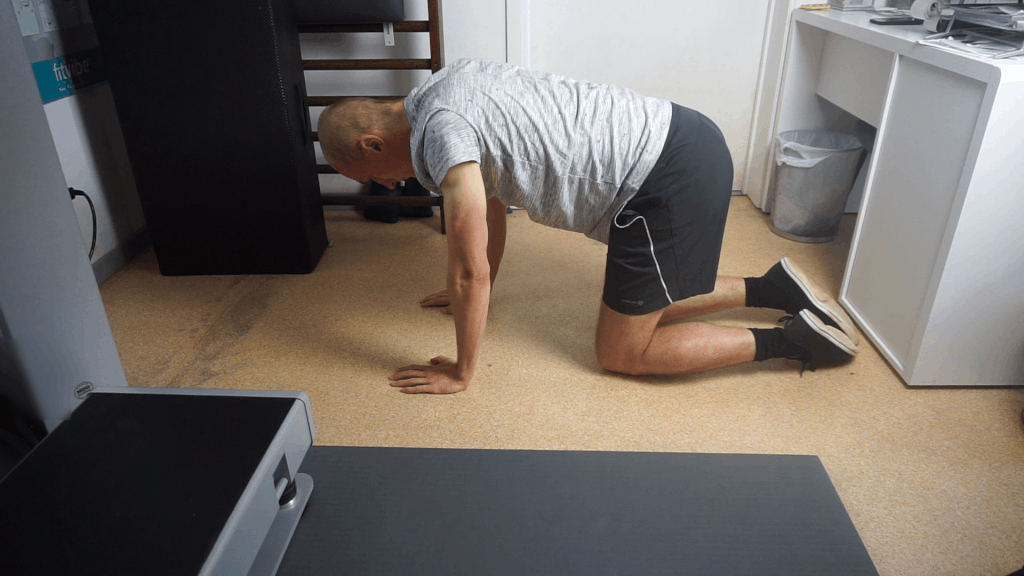There are many exercises that work one or more of your leg muscles. Find out how to do the fire hydrant and whether it is good.
The fire hydrant is an exercise where you sit on hands and knees and raise one leg sideways and up without moving your hips.
This movement mainly works your hip abductors (outer thigh muscles).
In turn, doing fire hydrants with enough resistance can help you grow and strengthen these muscles.
That being said, you do need to know that bodyweight fire hydrants will often not be hard enough to get this effect.
Instead, you want to add resistance bands or ankle weights to this exercise.
And even then, there are exercises that make it more convenient to work your outer thigh muscles.
How to do a fire hydrant
Take the following steps to do a fire hydrant:
- Sit on your hands and knees with your arms slightly less than stretched and shoulders above your wrists.
- Slowly move one leg sideways and up as far as you can without changing the angle of your hips. Keep the knee of this leg at about the same angle.
- Lower this leg back into starting position.
- Complete your set with one leg and then do the same number of repetitions with your other leg.

You mainly want to make sure your hips stay at about the same angle when doing fire hydrants.
This will make it so you can really isolate the main muscles of the exercise.
Muscles worked with the fire hydrant exercise
The main muscles you work with the fire hydrant exercise are your hip abductors aka your outer thigh muscles.
If you want to get specific, these hip abductors include your gluteus medius, gluteus minimus, and tensor fasciae latae.
It is important to note that just doing a few fire hydrants here and there is likely not enough to get to your training goals. Even if you do feel a “burn”.
More specifically, you still need to implement good set, rep, and resistance ranges.
How many fire hydrants you should do depends on your training goals.
As an example, to grow your outer thigh muscles, you would do 3 to 6 sets of 6 to 25 fire hydrants with a resistance that is very challenging.
Most people will want to do workouts like this every other day or even less often.
Keep in mind that bodyweight fire hydrants are likely not challenging enough to get in the ranges above.
To do this, you will likely need ankle weights or resistance bands.
Less optimal options include clamping a dumbbell or medicine ball between your upper and lower leg.
Benefits of the fire hydrant exercise
Fire hydrants are not necessarily the best exercise to work your outer thigh muscles but they still offer nice benefits. Some of these are:
- Flexibility and mobility: Fire hydrants can help you safely push the limits of how far your legs can move. In simpler words, they can help you improve flexibility and mobility.
- Stronger muscles: Doing fire hydrants with smart set and rep ranges can help you grow and strengthen your outer thigh muscles.
- Can improve thigh visuals: Many people will agree that growing your outer thigh muscles typically benefits your look.
If you like fire hydrants and these benefits align with your training goals, you can definitely do them more often.
Fire hydrant alternatives
At the same time, you may want to find out whether you like other outer thigh exercises or compound leg exercises more.
In that case, you can consider some of these fire hydrant alternatives:
- Weighted leg abductions
- Clamshell exercise
- Lying side leg raises
- Step-ups
- Bulgarian split squats
- Deadlifts
- Lunges
If you have trouble choosing between these fire hydrant alternatives, it can be helpful to think about what muscles you want to work.
Are fire hydrants a good exercise?
Fire hydrants can be a good exercise to work your hip abductors aka outer thigh muscles.
It is important to note that many people will need to add resistance to fire hydrants to see their desired results.
Additionally, you may find it easier to really work your outer thigh muscles with certain other glute isolation exercises.
Keeping your hips at the same angles during fire hydrants can be inconvenient. At least compared to something like lying side leg raises.
That being said, personal preference matters to some extent too.
If you like doing the fire hydrant exercise, you may find it easier to do this movement consistently.
Related posts:
FAQ
What is the fire hydrant exercise good for?
The fire hydrant exercise is mainly good for working your outer thigh muscles.
Are fire hydrants good for your thighs?
Fire hydrants can be good for growing and strengthening your outer thighs if you use enough resistance and do enough repetitions.
Do fire hydrants make your hips smaller?
Theoretically, fire hydrants could make your hips smaller if they help you lose thigh fat.
That being said, fire hydrants typically make your hips look slightly bigger by growing your outer thigh muscles.
